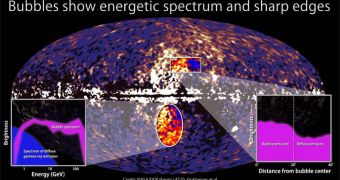In a groundbreaking new finding, researchers have determined that our galaxy is spewing out two massive bubbles of high-energy radiations, which could very well be the result of eruptions coming from the supermassive black hole at the core of the Milky Way.
The bubbles have been determined to originate in the center of the galaxy, and astrophysicists say that the structures are up to 25,000 light-years across. When transposing that to the visible sky, more than half the horizon is covered up.
One of the most peculiar things about these jets is that they emit light in the highest-energy wavelengths. The bubbles contain both X-rays and gamma-rays, investigators say, quoted by Space.
At this point, two main explanations are competing for attention in the international astronomical community. One of them says that the radiation were produced by a tremendously-active period of intense stellar formation at the core of the galaxy, which took place several million years ago.
The other possible explanation is that the bubbles were produced as the supermassive black hole that powers up the core of the Milky Way consumed a vast amount of hydrogen gas and cosmic dust from its accretion disk.
“We don't fully understand their nature or origin,” explains Harvard-Smithsonian Center for Astrophysics (CfA) scientist Doug Finkbeiner, who was also the lead investigator on the new study.
The expert and his team used data collected with the Large Area Telescope (LAT) instrument on the NASA Fermi Gamma-Ray Space Telescope, which is the most sensitive gamma-ray detector to have ever flown to space.
Despite their massive size, the bubbles only became apparent to researchers after they used filters to remove the background gamma-ray radiation that permeates the sky. The investigators were following leads set by other studied, which hinted at the existence of previously-unknown structures in the Milky Way.
“We were definitely looking for something. Some hints of this signal had been seen before, but not convincingly,” the team leader told reporters during a conference on Tuesday, November 9.
Speaking about the possibility that the bubbles were produced by accretion-related phenomena, Finkbeiner said that “this might be the first evidence for an outburst of activity of the black hole at the center of the galaxy.”
“Whatever the energy source behind these huge bubbles may be, it is connected to many deep questions in astrophysics” he concluded.

 14 DAY TRIAL //
14 DAY TRIAL //